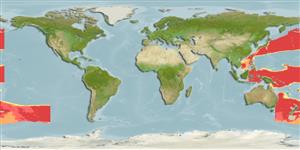>
Lophiiformes (Anglerfishes) >
Oneirodidae (Dreamers)
Etymology: Oneirodes: Greek, 'oneiros' = a dream or dreamlike or out of a dream (suggesting this fish is so strange and marvelous that can exist only in dreams) (Ref. 86949); sabex: Name from the acronym formed from the initial letters of the name 'Southeast Asian Bioluminescence EXpedition'; in recognition of the important ichthyological contribution made by those involved (Ref. 26783).
Environment: milieu / climate zone / depth range / distribution range
Écologie
marin bathypélagique; profondeur 780 - 1800 m (Ref. 86949). Deep-water
Pacific Ocean: SE Asia, Indonesian, eastern Australian and New Zealand waters.
Taille / Poids / Âge
Maturity: Lm ? range ? - ? cm
Max length : 18.9 cm SL (female); common length : 12.1 cm SL mâle / non sexé; (Ref. 26783)
Description synthétique
Morphologie | Morphométrie
Rayons mous dorsaux (Total): 5-6; Rayons mous anaux: 4. Characterized by having escal morphology: short anterior appendage, laterally compressed, without pigmented internal tube; presence of medial appendages; short, simple, cylindrical to laterally compressed; short and broad subopercle, dorsal end tapering to a point, without indentation on posterodorsal margin; length of ventral fork of opercle 24.2-27.1% SL; ratio of lengths of dorsal and ventral forks of opercle0.48-0.64; upper fork of opercle supported by 2-3 bony ribs in some large specimens; absence of epibranchial teeth; presence of teeth on pharyngobranchial II; upper jaw with 26-52; lower jaw teeth 36-50; teeth on vomer 4-10; dorsal fin rays 5-6; anal fin rays 4; pectoral fin rays 14-17; head length 32.2-39.5% SL; head depth 34.2-41.5% SL; premaxilla length 26-32.1% SL; length of lower jaw 33.2-45.3% SL; illicium length 14.4-26.5% SL (Ref. 86949).
Life cycle and mating behavior
Maturité | Reproduction | Frai | Œufs | Fécondité | Larves
Paxton, J.R., D.F. Hoese, G.R. Allen and J.E. Hanley, 1989. Pisces. Petromyzontidae to Carangidae. Zoological Catalogue of Australia, Vol. 7. Australian Government Publishing Service, Canberra, 665 p. (Ref. 7300)
Statut dans la liste rouge de l'IUCN (Ref. 130435)
Menace pour l'homme
Harmless
Utilisations par l'homme
Plus d'informations
Noms communsSynonymesMétabolismePrédateursÉcotoxicologieReproductionMaturitéFraiRassemblement de ponteFéconditéŒufsDéveloppement de l'œuf
Taille/ÂgeCroissanceLongueur-poidsLongueur-longueurFréquences de longueursMorphométrieMorphologieLarvesDynamique des populations larvairesRecrutementAbondanceBRUVS
RéférencesAquacultureProfil d'aquacultureSouchesGénétiqueElectrophoresesHéritabilitéPathologiesTraitementNutrientsMass conversion
CollaborateursImagesStamps, Coins Misc.SonsCiguateraVitesseType de nageSurface branchialeOtolithesCerveauxVision
Outils
Articles particuliers
Télécharger en XML
Sources Internet
Estimates based on models
Preferred temperature (Ref.
123201): 3.1 - 5.9, mean 4.4 °C (based on 309 cells).
Phylogenetic diversity index (Ref.
82804): PD
50 = 0.5000 [Uniqueness, from 0.5 = low to 2.0 = high].
Bayesian length-weight: a=0.01995 (0.00906 - 0.04395), b=3.01 (2.83 - 3.19), in cm total length, based on all LWR estimates for this body shape (Ref.
93245).
Niveau trophique (Ref.
69278): 4.3 ±0.7 se; based on size and trophs of closest relatives
Résilience (Ref.
120179): Milieu, temps minimum de doublement de population : 1,4 à 4,4 années (Preliminary K or Fecundity.).
Fishing Vulnerability (Ref.
59153): Low vulnerability (13 of 100).
